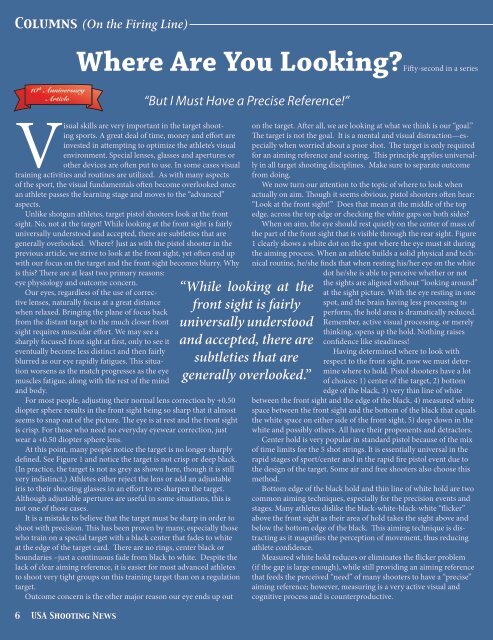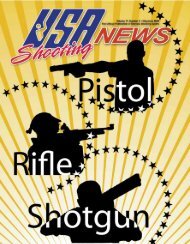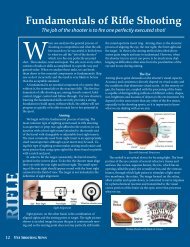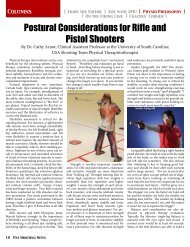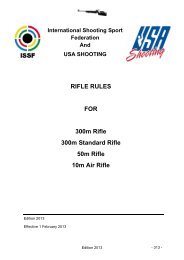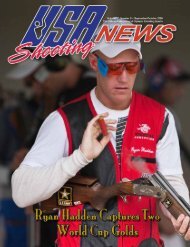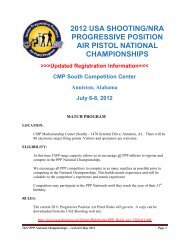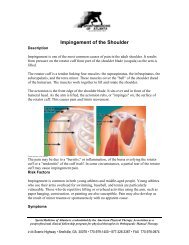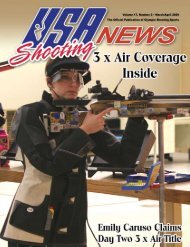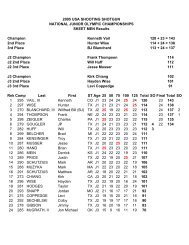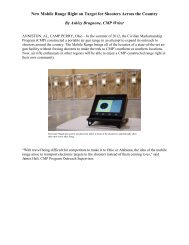November/December 2010: Volume 18, Number 6 - USA Shooting
November/December 2010: Volume 18, Number 6 - USA Shooting
November/December 2010: Volume 18, Number 6 - USA Shooting
- No tags were found...
Create successful ePaper yourself
Turn your PDF publications into a flip-book with our unique Google optimized e-Paper software.
Columns (On the Firing Line)Where Are You Looking?Fifty-second in a series10 th AnniversaryArticle“But I Must Have a Precise Reference!”Visual skills are very important in the target shootingsports. A great deal of time, money and effort areinvested in attempting to optimize the athlete’s visualenvironment. Special lenses, glasses and apertures orother devices are often put to use. In some cases visualtraining activities and routines are utilized. As with many aspectsof the sport, the visual fundamentals often become overlooked oncean athlete passes the learning stage and moves to the “advanced”aspects.Unlike shotgun athletes, target pistol shooters look at the frontsight. No, not at the target! While looking at the front sight is fairlyuniversally understood and accepted, there are subtleties that aregenerally overlooked. Where? Just as with the pistol shooter in theprevious article, we strive to look at the front sight, yet often end upwith our focus on the target and the front sight becomes blurry. Whyis this? There are at least two primary reasons:eye physiology and outcome concern.Our eyes, regardless of the use of correctivelenses, naturally focus at a great distancewhen relaxed. Bringing the plane of focus backfrom the distant target to the much closer frontsight requires muscular effort. We may see asharply focused front sight at first, only to see iteventually become less distinct and then fairlyblurred as our eye rapidly fatigues. This situationworsens as the match progresses as the eyemuscles fatigue, along with the rest of the mindand body.For most people, adjusting their normal lens correction by +0.50diopter sphere results in the front sight being so sharp that it almostseems to snap out of the picture. The eye is at rest and the front sightis crisp. For those who need no everyday eyewear correction, justwear a +0.50 diopter sphere lens.At this point, many people notice the target is no longer sharplydefined. See Figure 1 and notice the target is not crisp or deep black.(In practice, the target is not as grey as shown here, though it is stillvery indistinct.) Athletes either reject the lens or add an adjustableiris to their shooting glasses in an effort to re-sharpen the target.Although adjustable apertures are useful in some situations, this isnot one of those cases.It is a mistake to believe that the target must be sharp in order toshoot with precision. This has been proven by many, especially thosewho train on a special target with a black center that fades to whiteat the edge of the target card. There are no rings, center black orboundaries –just a continuous fade from black to white. Despite thelack of clear aiming reference, it is easier for most advanced athletesto shoot very tight groups on this training target than on a regulationtarget.Outcome concern is the other major reason our eye ends up out6 <strong>USA</strong> <strong>Shooting</strong> News“While looking at thefront sight is fairlyuniversally understoodand accepted, there aresubtleties that aregenerally overlooked.”on the target. After all, we are looking at what we think is our “goal.”The target is not the goal. It is a mental and visual distraction—especiallywhen worried about a poor shot. The target is only requiredfor an aiming reference and scoring. This principle applies universallyin all target shooting disciplines. Make sure to separate outcomefrom doing.We now turn our attention to the topic of where to look whenactually on aim. Though it seems obvious, pistol shooters often hear:“Look at the front sight!” Does that mean at the middle of the topedge, across the top edge or checking the white gaps on both sides?When on aim, the eye should rest quietly on the center of mass ofthe part of the front sight that is visible through the rear sight. Figure1 clearly shows a white dot on the spot where the eye must sit duringthe aiming process. When an athlete builds a solid physical and technicalroutine, he/she finds that when resting his/her eye on the whitedot he/she is able to perceive whether or notthe sights are aligned without “looking around”at the sight picture. With the eye resting in onespot, and the brain having less processing toperform, the hold area is dramatically reduced.Remember, active visual processing, or merelythinking, opens up the hold. Nothing raisesconfidence like steadiness!Having determined where to look withrespect to the front sight, now we must determinewhere to hold. Pistol shooters have a lotof choices: 1) center of the target, 2) bottomedge of the black, 3) very thin line of whitebetween the front sight and the edge of the black, 4) measured whitespace between the front sight and the bottom of the black that equalsthe white space on either side of the front sight, 5) deep down in thewhite and possibly others. All have their proponents and detractors.Center hold is very popular in standard pistol because of the mixof time limits for the 5 shot strings. It is essentially universal in therapid stages of sport/center and in the rapid fire pistol event due tothe design of the target. Some air and free shooters also choose thismethod.Bottom edge of the black hold and thin line of white hold are twocommon aiming techniques, especially for the precision events andstages. Many athletes dislike the black-white-black-white “flicker”above the front sight as their area of hold takes the sight above andbelow the bottom edge of the black. This aiming technique is distractingas it magnifies the perception of movement, thus reducingathlete confidence.Measured white hold reduces or eliminates the flicker problem(if the gap is large enough), while still providing an aiming referencethat feeds the perceived “need” of many shooters to have a “precise”aiming reference; however, measuring is a very active visual andcognitive process and is counterproductive.Nov-Dec Issue <strong>2010</strong>.indd 611/8/10 9:22 PM


